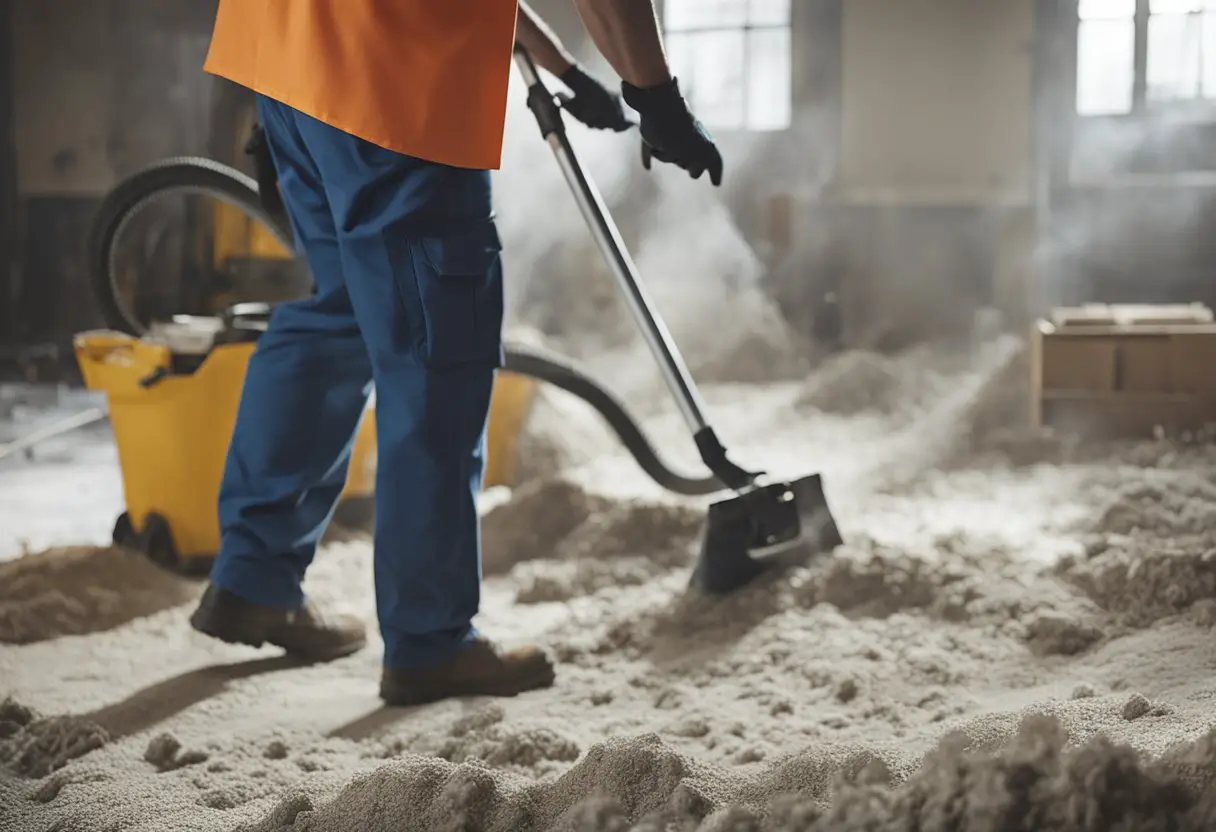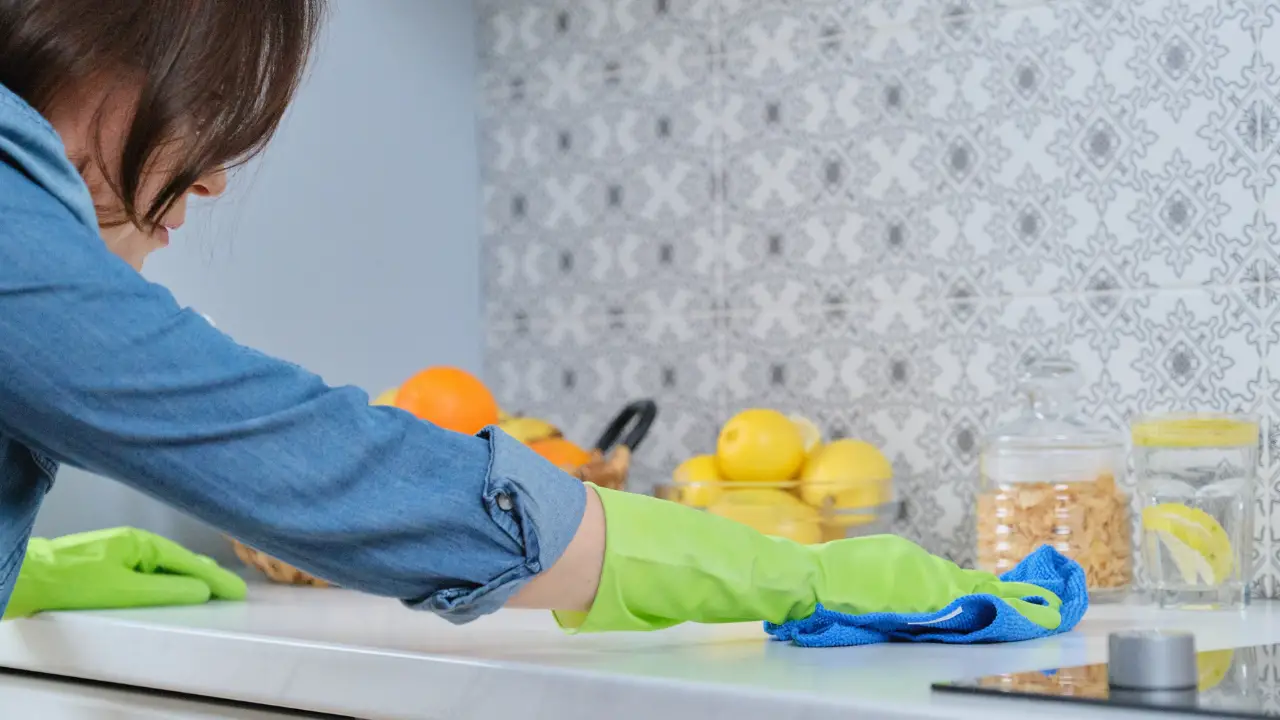Home renovations can be exciting, but they can also leave behind a lot of dust and debris. Post-construction cleanup is an essential step to ensure that your home is safe and clean after the renovation is complete.
Post-construction cleanup involves removing all the dust and debris left behind after a renovation. This includes everything from sawdust and drywall dust to nails and screws. The cleanup process can be time-consuming and labor-intensive, depending on the size of the renovation.
It’s essential to wear protective gear to guard against particle pollution. It’s recommended to wear personal protective equipment (PPE), including:
- Protective goggles that cover your eyes
- A professional-grade N95 mask
- Work gloves or rubber gloves if there’s a chance you may encounter liquid chemicals
The cleanup process typically involves the following steps:
- Remove construction debris: This includes disposing of large items like lumber, nails, and leftover materials.
- Sweep and vacuum: Sweep up dust and debris, then vacuum all surfaces to remove fine particles.
- Clean surfaces: Wipe down walls, ceilings, floors, and other surfaces with a damp cloth to remove any remaining dust and debris.
- Disinfect surfaces: Use a disinfectant spray or wipes to kill any germs or bacteria that may be present.
- Air out the space: Open windows and doors to allow fresh air to circulate and help remove any remaining dust and odors.
Table of Contents
Importance of Tackling Dust and Debris After Home Renovations
Home renovations are exciting and can greatly improve the look and feel of your living space. However, they also come with a lot of dust and debris that can be hazardous to your health if not properly cleaned up. Tackling dust and debris after home renovations is crucial for a number of reasons.
First and foremost, dust and debris can cause respiratory issues. When inhaled, dust particles can irritate your lungs and cause coughing, wheezing, and shortness of breath. This is especially true for construction dust, which can contain harmful particles like silica. By properly cleaning up after a renovation, you can reduce the risk of respiratory issues for you and your family.
If you or someone in your household suffers from allergies, the dust and debris left behind after a renovation can exacerbate symptoms. By cleaning up thoroughly, you can reduce the risk of allergy flare-ups.

Another important reason to tackle dust and debris after a home renovation is to prevent damage to your home. Dust can settle on surfaces and cause damage over time, especially if it contains abrasive particles like silica. By cleaning up thoroughly, you can prevent damage to your furniture, flooring, and other surfaces.
Safety Measures in Post-Construction Cleanup
When it comes to post-construction cleanup, safety should always be a top priority. Here are some key safety measures you should consider when tackling dust and debris after home renovations.
Use of Personal Protective Equipment

Personal protective equipment (PPE) is essential for anyone involved in the post-construction cleanup process. This equipment helps to protect workers from exposure to dust, debris, and hazardous materials. Some common types of PPE that you may need to use include:
- Safety glasses to protect your eyes from dust and debris
- Sturdy work gloves to protect your hands from sharp objects and harsh cleaning agents
- Hard hats to shield against falling objects
- Respirators to protect against dust and other airborne particles
Before starting the cleanup process, make sure that you and your team have the appropriate PPE for the job. It’s also important to ensure that everyone knows how to use the equipment properly.
Proper Handling of Debris
Handling debris can be dangerous if not done properly. Here are some tips to help you handle debris safely:
- Use caution when handling sharp objects like nails, screws, and broken glass.
- Wear gloves to protect your hands from cuts and punctures.
- Use proper lifting techniques to avoid back strain or injury.
- Dispose of debris in designated containers or dumpsters.
It’s also important to properly identify and handle hazardous materials such as asbestos or lead-based paint. If you are unsure about how to handle hazardous materials, consider hiring a professional to help with the cleanup process.
Tools and Materials for Post-Construction Cleanup

When it comes to post-construction cleanup, having the right tools and materials can make all the difference. Here are some essential items you’ll want to have on hand:
Vacuum Cleaners
One of the most important tools for post-construction cleanup is a high-quality vacuum cleaner. Look for a model that is designed to handle fine dust and debris, such as a HEPA vacuum. This type of vacuum has a filter that is capable of capturing small particles, which is essential for removing construction dust.
In addition to a traditional upright vacuum, you may also want to consider a backpack vacuum. This type of vacuum is worn on your back, making it easier to maneuver around the construction site. It’s also ideal for cleaning hard-to-reach areas, such as ceilings and walls.
Air Scrubbers
Another essential tool for post-construction cleanup is an air scrubber. This device helps to remove dust and other airborne particles from the air, improving the air quality in your home. Look for an air scrubber that has a HEPA filter, which is capable of capturing even the smallest particles.
Dust Mops
Dust mops are another must-have tool for post-construction cleanup. These mops are designed to pick up dust and debris from hard surfaces, such as hardwood floors and tile. Look for a dust mop with a removable head, which makes it easier to clean and maintain.
In addition to these tools, you’ll also want to have plenty of heavy-duty trash bags, brooms, and dust pans on hand. With the right tools and materials, you can tackle post-construction cleanup with confidence and ease.
The Process of Post-Construction Cleanup

Post-construction cleanup is a crucial step in any renovation or construction project. It involves removing dust, debris, and other materials left behind after the construction work is completed. The process of post-construction cleanup can be broken down into two main steps: initial sweep and detailed cleaning.
Initial Sweep
The initial sweep is the first step in the post-construction cleanup process. During this step, you will need to remove all large debris and materials left behind after the construction work is completed. This includes disposing of large items like lumber, nails, and leftover materials. You will also need to sweep up dust and debris from floors, walls, and other surfaces.
To effectively remove dust and debris, it is recommended to use a high-quality vacuum cleaner with a HEPA filter. This will help to capture small particles and prevent them from being released back into the air. You should also wear personal protective equipment (PPE), including protective goggles, a professional-grade N95 mask, and work gloves or rubber gloves if there’s a chance you may encounter liquid chemicals.
Detailed Cleaning
The detailed cleaning step is the second and final step in the post-construction cleanup process. During this step, you will need to thoroughly clean all surfaces, including walls, ceilings, floors, and other surfaces. You should wipe down all surfaces with a damp cloth or mop to remove any remaining dust or debris.
It is important to note that different surfaces may require different cleaning methods. For example, hardwood floors may require a different cleaning solution than tile floors. Make sure to follow the manufacturer’s instructions when cleaning different surfaces to avoid damaging them.
In addition to cleaning surfaces, you should also clean all fixtures and appliances in the area. This includes light fixtures, switches, outlets, and appliances like refrigerators and stoves. Make sure to use a cleaning solution that is safe for each fixture or appliance.
Hiring Professionals for Post-Construction Cleanup
Cleaning up after a home renovation or construction project can be a daunting task, especially if you are not equipped with the right tools and knowledge. If you want to ensure that your living space is free of dust and debris, hiring professionals for post-construction cleanup is a great option.
Professional cleaners have the experience, skills, and equipment needed to get the job done efficiently and effectively. They know the best methods and products to use for different types of surfaces and stains, and they have access to powerful vacuums and air purifiers that can remove even the smallest particles of dust.
In addition, hiring professionals for post-construction cleanup can help you avoid health risks associated with exposure to construction dust. Dust particles can irritate your eyes, nose, and throat, and can cause respiratory problems if inhaled. Professional cleaners are equipped with protective gear to guard their eyes and lungs from the particle pollution.
When hiring professionals for post-construction cleanup, it’s important to choose a reputable company with a proven track record of success. Look for reviews and ratings online, and ask for references from previous clients. Make sure that the company is licensed, insured, and bonded, and that their employees undergo background checks and drug testing.
DIY Post-Construction Cleanup Tips
Cleaning up after a home renovation or construction project can be a daunting task, but with proper planning and systematic cleaning, you can tackle the dust and debris like a pro. Here are some DIY post-construction cleanup tips to help you get started.
Proper Planning
Before you begin cleaning, it’s important to plan ahead and gather the necessary tools and supplies. Here are some items you may need:
- Dust masks: Protect your lungs from the fine particles of dust that are often present during post-construction cleaning.
- Heavy-duty vacuum: A powerful vacuum with a HEPA filter can help you remove dust and debris from carpets, upholstery, and hard surfaces.
- Microfiber cloths: These are great for wiping down surfaces and picking up dust without leaving streaks or scratches.
- Mops and buckets: Use these to clean hard floors and remove any remaining dust and debris.
- Trash bags: You’ll need plenty of sturdy bags to dispose of debris and other waste.
Systematic Cleaning
Once you have your supplies ready, it’s time to start cleaning. Here are some tips to help you clean systematically:
- Start at the top: Begin cleaning from the top of the room and work your way down. This will help prevent dust and debris from falling onto surfaces you have already cleaned.
- Clean in sections: Divide the room into sections and clean them one at a time. This will help you stay organized and ensure that you don’t miss any spots.
- Vacuum before wiping: Use a vacuum to remove as much dust and debris as possible before wiping down surfaces with a microfiber cloth. This will help prevent scratches and damage to delicate surfaces.
- Use the right cleaning products: Make sure you use the appropriate cleaning products for each surface. For example, use a mild detergent and warm water to clean painted walls, and a wood cleaner to clean hardwood floors.
Disposal of Debris
Proper disposal of debris is an important part of post-construction cleanup. Here are some tips to help you dispose of debris safely and efficiently:
- Separate recyclables: Separate materials that can be recycled, such as cardboard, metal, and plastic, from other waste.
- Rent a dumpster: If you have a lot of debris to dispose of, consider renting a dumpster. This will make it easier to dispose of large items and prevent clutter from piling up.
- Hire a hauling service: If you don’t have the time or resources to dispose of debris yourself, consider hiring a hauling service. They can take care of all the heavy lifting and ensure that your waste is disposed of properly.




